CEMENT BATCH PLANT

AP TECHNIC cement batching plants have a continuous throughput ranging from 100 to 600 t/h. The cement batching unit is available in two versions: fixed or mobile. Advantage The advantage of a mob ...
Read more
AP TECHNIC cement batching plants have a continuous throughput ranging from 100 to 600 t/h. The cement batching unit is available in two versions: fixed or mobile. Advantage The advantage of a mob ...
Read more
Cement-based aggregate is a mixture of aggregates (sand, gravel, fines) and a hydraulic binder (usually cement), to which a small amount of water is added. Once compacted and hardened, it forms a rigid subbase for roadways.
It is a material treated with hydraulic binders (HLB), used to:
What thickness should the cement-based gravel be?
The thickness of a cement-based gravel layer depends on the structure of the roadway and its intended use (light road, national road, motorway, industrial zone, etc.). Generally, the following thicknesses are used:
The precise dimensions are defined by geotechnical studies and current standards (such as the SETRA guide in France).
Cement-based gravel offers several major advantages:
It is therefore often used as a base layer before the installation of asphalt or surface concrete.
A.P. Technic 27 rue du moulin de groleau 49490 Noyant-Villages - FRANCE Tél. +33 (0) 241 890 373 Contact us